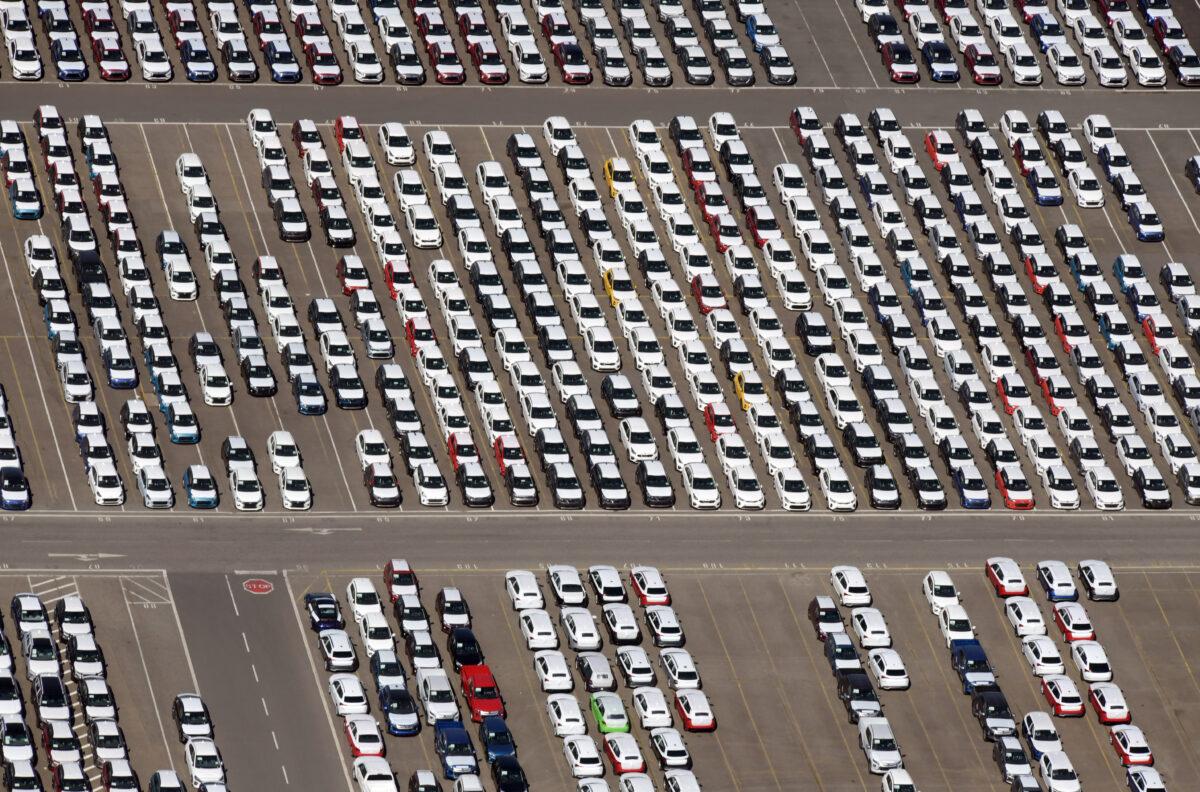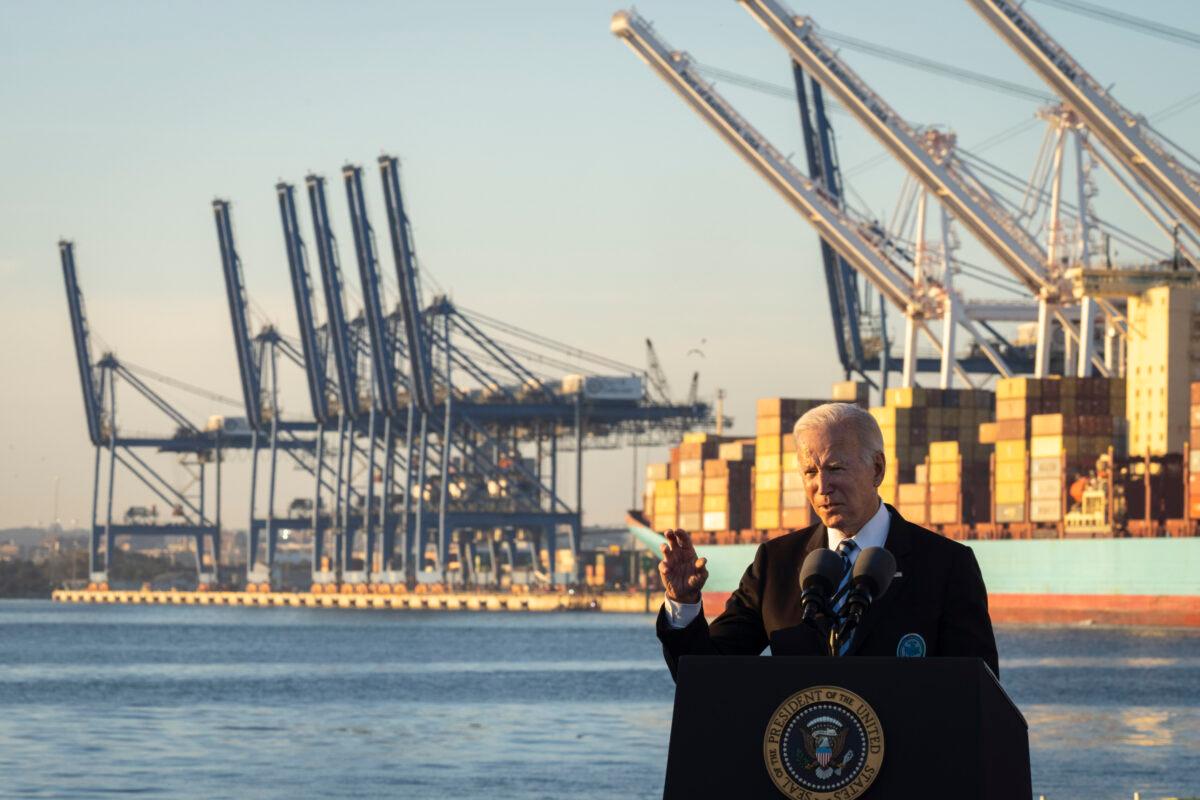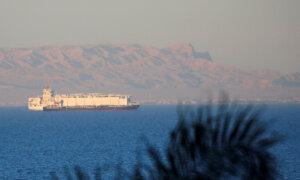With lessons learned from the COVID-19 pandemic, retailers, manufacturers, and the shipping and transport ecosystem are adjusting
American retailers are currently placing orders with global manufacturers and reserving space on commercial carriers for the back-to-school sales in August and the Christmas sales in December.
That’s at least 14 days ahead of schedule, one of the many “impacts of Red Sea shipping disruptions,” Jonathan Gold, vice president of supply chain and customs policy at the National Retail Federation (NRF), told a House panel on Jan. 30.
Attacks on shipping in the Red Sea’s Bab-el-Mandeb Strait since November by Houthi terrorists have prompted many carriers, including Denmark-based Maersk and France’s CMA CGM, to avoid it, thereby increasing transit times and costs.
The Red Sea route accounts for up to 15 percent of global trade and 20 percent of worldwide container traffic, according to the U.S. State Department.
During the first two weeks of 2024, Suez transits were down 64 percent compared to the same period in 2023, according to London-based Drewry. Over the same span, transits around the Cape of Good Hope increased by 168 percent, the maritime research consultancy reported.
Global shipping was already stressed by abnormally low water levels in the Panama Canal, which have led to a 36-percent decrease in transits compared to 2023, and a 62-percent decrease compared to 2022.
As a result, average shipping rates to China have doubled and those to Europe have tripled, according to Container xChange, an online container leasing and trading platform based in Hamburg, Germany.
“The U.S. economy will be affected by this crisis in the Red Sea. The only question is how much,” Rep. Salud Carbajal (D-Calif.) said during the two-hour hearing before the House Transportation & Infrastructure Committee’s subcommittee on coast guard and maritime transportation .
“We have seen carriers reroute ships around Africa, insurance costs skyrocket, increased container rates, longer transit times for goods to arrive at their destinations,” subcommittee chair Rep. Daniel Webster (R-Fla.) said.
Diverting ships around Africa adds up to 12 days to transits, “increasing carbon emissions and $1 million in operating costs [on average] for these voyages,” Rep. Rick Larsen (D-Wash.) said. “Those who do transit the Red Sea faced significant increases in their insurance premiums or [they are] dropped altogether. In either case, the end result is higher prices for U.S. consumers,” he added.
The NRF is the world’s largest retail association, boasting more than 16,000 members who employ 52 million Americans and contribute $3.9 trillion to the nation’s GDP.
With increases of up to 14 days in shipping time, “members are seeing a rise in shipping costs,” Mr. Gold said. “There’s been a significant increase in freight rates.”
Carriers are seeking “a number of different surcharges and fees including war risk and surcharges, emergency contingency surcharges and others.”
Increases are understandable, he said, but “our members want to make sure these fees and surcharges cover real costs and are not intended for profit.”
Mr. Gold said one NRF member told him carriers were seeking increases of $1,500 to $3,000 per container, hikes of 30 to 73 percent.

‘Expect The Unexpected’
Lessons learned from the supply chain disruptions during the COVID-19 pandemic, which idled goods in congested ports and aboard anchored container ships, are still fresh in retailers’ minds, Mr. Gold said.
“It taught us to expect the unexpected and not think you really can predict what’s coming next, to be as nimble as possible,” Mediterranean Shipping Company (MSC) executive vice president Bud Darr said. “And it’s forced us to maintain some additional capacity at substantial costs to respond” to the unexpected.
During the pandemic, he said, swamped ports operated at 115 to 120 percent capacity. Unloaded ships were anchored offshore with railroads barely running and trucks idling in parking lots.
“One major difference with what we face today is those shoreside components are not showing the incredible stress they were under during the pandemic,” Mr. Darr said, noting port terminals where MSC ships berth are at about 60 percent capacity.
“Because we kept that additional capacity available, we’ve been able to deploy it and, although it takes longer, and, although it has some additional costs associated with it, we’re making it work and the goods are moving,” he said.
One thing we learned from the supply chain crunch is what happens when we’re relying on a supply chain dominated by foreign interests, said Rep. Salud Carbajal (D-Calif.), who then asked Mr. Gold what NRF members are doing to increase the share of cargo transported on U.S.-flagged ships.
Retailers are “continuously looking at diversifying supply chains away from China or elsewhere but it takes time and, unfortunately, with ongoing challenges that we see, when you look to diversify, you’re being impacted by something else. Unfortunately, we’re not able to bring everything back here to make,” Mr. Gold said.
“There’s an intensifying focus on friends’ on-shoring, allied shoring, but it takes time to develop them,” he continued. “So, they’re doing what they can to make sure products are getting here when they need to be here for the consumer.”
The lessons may be applicable, Rep. Rick Larsen (D-Wash.) said, but the situations are very different.
During the COVID-19 pandemic “we had the backups at the ports but things could get there,” he said. “This is sort of the opposite, things are having trouble getting to the ports because [of] the attacks, but our ports largely are resilient, more resilient than they had been during COVID. There is extra capacity available.”

‘We Will Make It Work’
Mr. Darr said continued investment in port infrastructure, warehouse capacity, rail/road networks, and operational practices “can help insulate us for future crises” because shoreside capacity “was essentially what failed us” during the pandemic.
Mr. Larsen said the 2021 Bipartisan Infrastructure Law earmarks $2.25 billion for port infrastructure and development.
“That investment will help ensure ports are prepared for inevitable fluctuations in cargo that jeopardize the seamless movement of goods,” he said. “That means continued investments in roads, rail airports, ports, vessels and the women and men that make our transportation system work.”
“I agree,” Mr. Gold said. “That focus on infrastructure on the land side is critically important but we’re also looking at the IT subsystems. I think one of the areas where we kind of failed throughout the pandemic was that communication aspect.
“We’ve got to make sure all the stakeholders, the carriers, terminals, trucks, railroads, warehouses, the shippers, are all talking to each other to understand what’s happening at any point in time,” he continued. “Making sure we have equipment readily available, the cranes, the rail cars, are there when they need to be there.”
Mr. Darr believes the Red Sea will remain dangerous “for a while” but the “shipping-and-transport ecosystem” will adjust, adapt, and normalize.
“The market will take over again and pricing will reflect equity from carrier to carrier, customer to customer, over time, as the market normally can do,” he said. “We will adapt. We will make it work. We will meet the world’s commerce needs. That’s what we do. But it may not look like it does today.”
Original News Source Link – Epoch Times
Running For Office? Conservative Campaign Consulting – Election Day Strategies!


